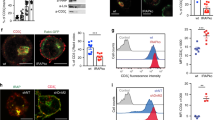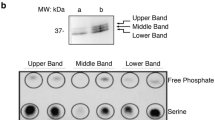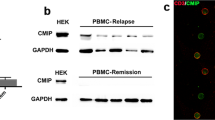Abstract
Signaling-responsive MAP kinases (MAPKs) are key in mediating immune responses and are activated through the phosphorylation of a Thr-X-Tyr motif by upstream MAPK kinases. Here we show that T cells stimulated through the T cell receptor (TCR) used an alternative mechanism in which p38 was phosphorylated on Tyr323 and subsequently autophosphorylated residues Thr180 and Tyr182. This required the TCR-proximal tyrosine kinase Zap70 but not the adaptor protein LAT, which was required for activation of extracellular signal–regulated protein kinase MAPKs. TCR activation of p38 lacking Tyr323 was diminished, and blocking of p38 activity prevented p38 dual phosphorylation in normal T cells but not in B cells. Thus, phosphorylation of Tyr323 dependent on the tyrosine kinase Lck and mediated by Zap70 serves as an important mechanism for TCR activation of p38 in T cells.
This is a preview of subscription content, access via your institution
Access options
Subscribe to this journal
Receive 12 print issues and online access
$209.00 per year
only $17.42 per issue
Buy this article
- Purchase on Springer Link
- Instant access to full article PDF
Prices may be subject to local taxes which are calculated during checkout






Similar content being viewed by others
References
Chang, L. & Karin, M. Mammalian MAP kinase signalling cascades. Nature 410, 37–40 (2001).
Dong, C., Davis, R.J. & Flavell, R.A. MAP kinases in the immune response. Annu. Rev. Immunol. 20, 55–72 (2002).
Rincon, M. et al. Conference highlight: do T cells care about the mitogen-activated protein kinase signalling pathways. Immunol. Cell Biol. 78, 166–175 (2000).
Rincon, M., Flavell, R.A. & Davis, R.A. The JNK and P38 MAP kinase signaling pathways in T cell-mediated immune responses. Free Radic. Biol. Med. 28, 1328–1337 (2000).
Rincon, M., Flavell, R.A. & Davis, R.J. Signal transduction by MAP kinases in T lymphocytes. Oncogene 20, 2490–2497 (2001).
Schaeffer, H.J. & Weber, M.J. Mitogen-activated protein kinases: specific messages from ubiquitous messengers. Mol. Cell. Biol. 19, 2435–2444 (1999).
Davis, R.J. Signal transduction by the JNK group of MAP kinases. Cell 103, 239–252 (2000).
Dong, C. et al. JNK is required for effector T-cell function but not for T-cell activation. Nature 405, 91–94 (2000).
Han, J. & Ulevitch, R.J. Emerging targets for anti-inflammatory therapy. Nat. Cell Biol. 1, E39–E40 (1999).
Rincon, M. MAP-kinase signaling pathways in T cells. Curr. Opin. Immunol. 13, 339–345 (2001).
Bellon, S., Fitzgibbon, M.J., Fox, T., Hsiao, H.M. & Wilson, K.P. The structure of phosphorylated p38γ is monomeric and reveals a conserved activation-loop conformation. Structure Fold. Des. 7, 1057–1065 (1999).
Canagarajah, B.J., Khokhlatchev, A., Cobb, M.H. & Goldsmith, E.J. Activation mechanism of the MAP kinase ERK2 by dual phosphorylation. Cell 90, 859–869 (1997).
Ono, K. & Han, J. The p38 signal transduction pathway: activation and function. Cell. Signal. 12, 1–13 (2000).
Tanaka, N. et al. Differential involvement of p38 mitogen-activated protein kinase kinases MKK3 and MKK6 in T-cell apoptosis. EMBO Rep. 3, 785–791 (2002).
Zhang, J. et al. p38 mitogen-activated protein kinase mediates signal integration of TCR/CD28 costimulation in primary murine T cells. J. Immunol. 162, 3819–3829 (1999).
Rincon, M. et al. Interferon-γ expression by Th1 effector T cells mediated by the p38 MAP kinase signaling pathway. EMBO J. 17, 2817–2829 (1998).
Ward, S.G., Parry, R.V., Matthews, J. & O'Neill, L. A p38 MAP kinase inhibitor SB203580 inhibits CD28-dependent T cell proliferation and IL-2 production. Biochem. Soc. Trans. 25, 304S (1997).
Crawley, J.B. et al. T cell proliferation in response to interleukins 2 and 7 requires p38MAP kinase activation. J. Biol. Chem. 272, 15023–15027 (1997).
Matsuda, S., Moriguchi, T., Koyasu, S. & Nishida, E. T lymphocyte activation signals for interleukin-2 production involve activation of MKK6-p38 and MKK7-SAPK/JNK signaling pathways sensitive to cyclosporin A. J. Biol. Chem. 273, 12378–12382 (1998).
Haeryfar, S.M. & Hoskin, D.W. Selective pharmacological inhibitors reveal differences between Thy-1- and T cell receptor-mediated signal transduction in mouse T lymphocytes. Int. Immunopharmacol. 1, 689–698 (2001).
Jiang, Y. et al. Structure-function studies of p38 mitogen-activated protein kinase. Loop 12 influences substrate specificity and autophosphorylation, but not upstream kinase selection. J. Biol. Chem. 272, 11096–11102 (1997).
Finco, T.S., Kadlecek, T., Zhang, W., Samelson, L.E. & Weiss, A. LAT is required for TCR-mediated activation of PLCγ1 and the Ras pathway. Immunity 9, 617–626 (1998).
Chan, A.C., Desai, D.M. & Weiss, A. The role of protein tyrosine kinases and protein tyrosine phosphatases in T cell antigen receptor signal transduction. Annu. Rev. Immunol. 12, 555–592 (1994).
Williams, B.L. et al. Genetic evidence for differential coupling of Syk family kinases to the T-cell receptor: reconstitution studies in a ZAP-70-deficient Jurkat T-cell line. Mol. Cell. Biol. 18, 1388–1399 (1998).
Steinberg, M. et al. T-cell receptor-induced phosphorylation of the ζ chain is efficiently promoted by ZAP-70 but not Syk. Blood 104, 760–767 (2004).
Salojin, K.V., Zhang, J. & Delovitch, T.L. TCR and CD28 are coupled via ZAP-70 to the activation of the Vav/Rac-1-/PAK-1/p38 MAPK signaling pathway. J. Immunol. 163, 844–853 (1999).
Yu, H., Leitenberg, D., Li, B. & Flavell, R.A. Deficiency of small GTPase Rac2 affects T cell activation. J. Exp. Med. 194, 915–926 (2001).
Salvador, J.M., Mittelstadt, P.R., Belova, G.I., Fornace, A.J., Jr & Ashwell, J.D. The autoimmune suppressor GADD45α inhibits the T cell alternative p38 activation pathway. Nat. Immunol. (27 February 2005) 10.1038/ni1176.
Chi, H., Lu, B., Takekawa, M., Davis, R.J. & Flavell, R.A. GADD45β/GADD45γ and MEKK4 comprise a genetic pathway mediating STAT4-independent IFNγ production in T cells. EMBO J. 23, 1576–1586 (2004).
Wilson, K.P. et al. Crystal structure of p38 mitogen-activated protein kinase. J. Biol. Chem. 271, 27696–27700 (1996).
Weiss, A. & Littman, D.R. Signal transduction by lymphocyte antigen receptors. Cell 76, 263–274 (1994).
Bell, M. & Engelberg, D. Phosphorylation of Tyr-176 of the yeast MAPK Hog1/p38 is not vital for Hog1 biological activity. J. Biol. Chem. 278, 14603–14606 (2003).
Ge, B. et al. MAPKK-independent activation of p38α mediated by TAB1-dependent autophosphorylation of p38α. Science 295, 1291–1294 (2002).
D'Oro, U., Sakaguchi, K., Appella, E. & Ashwell, J.D. Mutational analysis of Lck in CD45-negative T cells: dominant role of tyrosine 394 phosphorylation in kinase activity. Mol. Cell. Biol. 16, 4996–5003 (1996).
Salvador, J.M. et al. Mice lacking the p53-effector gene Gadd45a develop a lupus-like syndrome. Immunity 16, 499–508 (2002).
Acknowledgements
We thank S. Gutkind for critical review of this manuscript.
Author information
Authors and Affiliations
Corresponding author
Ethics declarations
Competing interests
The authors declare no competing financial interests.
Supplementary information
Supplementary Fig. 1
SB203580 inhibits T cell p38 autophosphorylation. (PDF 148 kb)
Supplementary Fig. 2
Zap70 phosphorylates p38 on Try-323. (PDF 53 kb)
Supplementary Fig. 3
Specificity of affinity-purified anti-phospho-323 p38 antibody. (PDF 92 kb)
Rights and permissions
About this article
Cite this article
Salvador, J., Mittelstadt, P., Guszczynski, T. et al. Alternative p38 activation pathway mediated by T cell receptor–proximal tyrosine kinases. Nat Immunol 6, 390–395 (2005). https://doi.org/10.1038/ni1177
Received:
Accepted:
Published:
Issue Date:
DOI: https://doi.org/10.1038/ni1177
This article is cited by
-
p38 MAPK signaling in chronic obstructive pulmonary disease pathogenesis and inhibitor therapeutics
Cell Communication and Signaling (2023)
-
Characterization of p38α autophosphorylation inhibitors that target the non-canonical activation pathway
Nature Communications (2023)
-
Fluorescence resonance energy transfer (FRET) spatiotemporal mapping of atypical P38 reveals an endosomal and cytosolic spatial bias
Scientific Reports (2023)
-
Hsp90 modulates human sperm capacitation via the Erk1/2 and p38 MAPK signaling pathways
Reproductive Biology and Endocrinology (2021)
-
Diversity and versatility of p38 kinase signalling in health and disease
Nature Reviews Molecular Cell Biology (2021)



